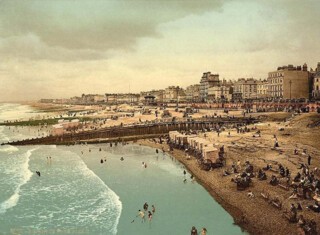Visiting the sea for its own sake is a two-hundred-year-old idea, roughly speaking. John Nash finished his expansion of the Royal Pavilion in Brighton in 1822. A few years later, Boulogne, on the other side of the Channel, became an early beach resort: ‘You will find whatever you are looking for there,’ Manet wrote to a friend.
Going to the beach – by train on the new railways – swiftly became fashionable in Europe and North America. Piers were an addition to beach resorts of the 1850s and 1860s; at first they were landing jetties for towns that had no harbour, but became an entity in their own right. Brighton had several, and became the epitome of the beach. ‘You hear nothing and see nothing,’ Richard Jeffries wrote of Brighton’s beach in The Open Air (1885):
It is perfectly comfortable, perfectly jolly and exhilarating, a preferable spot to any other. A sparkle of sunshine on the breakers, a dazzling gleam from the white foam, a warm sweet air, light and brightness and champagniness; altogether lovely. The way in which people lie about on the beach, their legs this way and their arms that, their hats over their eyes, their utter give-themselves-up expression of attitude is enough in itself, to make a reasonable being contented.
That ‘utter give-themselves-up expression’ is still familiar 140 years on.
Three English words about the coast have uncertain or obscure origins: ‘beach’ is one of them, ‘shingle’ another, ‘pebble’ a third. ‘You’re not the only pebble on the beach’ was the title of a 19th-century song that has become a saying. ‘Dear Henry,’ William James wrote to his physician friend Henry Bowditch, ‘you see that you are not the only pebble on the beach, or toad in the puddle of senile degeneration.’
‘What is a pebble?’ is the opening sentence of Clarence Ellis’s book The Pebbles on the Beach, first published by Faber in 1954 and now reissued.* If ever there was a beach book, Ellis’s is it. He wrote it with the idea of encouraging beach visitors to collect pebbles, which had been quite the craze in the 1820s and 1830s. Ellis’s obvious question has a complex answer. A pebble, he explains, isn’t necessarily small or round; pebbles, gravel and sand all work on each other. All stones on a shingle beach, he says, are pebbles ‘complete or in the making’. Pebbles begin as a fragment of rock that through natural agency has broken away from the rockface. ‘The weather, very slowly, but very surely, breaks down even the hardest rock. Sun, wind and rain gradually etch its surface.’ Everything about the coastal environment, Ellis says, ‘contributes to the slow disintegration’.
We must always bear in mind that a pebble is a transient thing. It is in the halfway stage of a long existence. Beginning as a fragment of rock, which itself is millions of years old, it ends its existence by being pounded into minute particles or grains. Similarly, the shingle beach which consists entirely of pebbles is also transient, for it is constantly being moved along the shore by the action of waves.
Swash, backwash, longshore drift and fetch are terms for the action of waves on beaches. Far-fetched waves, for example, are those that crash onto the Cornish coast having travelled great distances. There are three groups of pebble, Ellis writes: spheres, ovoids and flattened ovoids – or discs. ‘Between the first and the second, and between the second and the third, there is an infinite number of gradations.’ The new edition, which has an introduction by Robert Macfarlane, has an illustrated gate-post cover showing a variety of pebbles: a piece of amber from the Suffolk coast, a fragment of jet from the Yorkshire coast near Whitby. Nothing is static about a shoreline. Ancient glaciers made and carried colossal quantities of pebbles, gravel and sand within them, and they themselves were the grinding agents that created more of the same. The distances these stones travelled were huge: pebbles on the beach may originally have been pieces of a rock hundreds or even thousands of miles away (these are known as erratics).
In a photograph taken in the early 1970s on Dunwich beach, I am standing on a large lump of masonry that has tumbled down from the top of the cliff; it lies on the shingle at the water’s edge. In the picture, the swash has made a small island of it. That lump of mortar and flint, building materials common to thousands of medieval East Anglian buildings, was destroyed by the North Sea years ago. Much of the old Dunwich that still stood at the top of the cliff in the early 1970s has gone: the cliff’s clay, sand, gravel and pebbles present little resistance to the force of waves, wind and rain – as Ellis points out, the corrosive power of wind-driven sand is quite something. I walked on that beach last year. The scene looks almost the same as the day the photograph was taken. But it really isn’t: coastal erosion is relentless; the apparently unchanging scene is never not changing.
Further down the Suffolk coast, the Orwell Estuary encompasses the tidal waters between Felixstowe and Ipswich. On its southern shore, halfway between the two towns, is Pin Mill, a village where Arthur Ransome lived. The inn at Pin Mill is called the Butt and Oyster: through its windows you see boats that at low tide rest on the sandy, seaweed-covered shore. Some of them are flat-bottomed Thames barges, the type of sailing boat that once traded between the East Anglian coast, the capital and the continent. They were designed without a fixed keel so that they could be manoeuvred through shallow water, at sea and inland, and through the intermingling of shore and land on the coasts of East Anglia, Holland and Belgium. The oyster beds in the estuary were once prodigious, but there now are few, if any, oysters, on the shore or at the inn. The owners of the Butt and Oyster are proud that their inn was a smugglers’ haven, but almost every stretch of coast facing the continent has a smuggling history, and until beaches became associated with holidays, they tended to be places people avoided, unless you worked from them as a merchant or fisherman.
Beaches in the UK are open to everyone, unless they form part of a naval base. They are more exclusive elsewhere. Those written up in the Financial Times’s How To Spend It magazine aren’t just exclusive but expensive and remote, sometimes set on atolls in the middle of oceans. In Florida, security guards protect the many private beaches – the strip of sand between the high and low tide marks is public, but reaching it may be impossible because the rest of the beach is private.
Exclusive, expensive and private define Mar-a-Lago, Donald Trump’s Palm Beach club. The name – ‘between sea and lagoon’ – was chosen by its first owner, Marjorie Merriweather Post, who inherited one fortune and made another from frozen food. The architect was Joseph Urban, an Austrian émigré who designed sets for the Metropolitan Opera in New York and for Randolph Hearst’s films. He ordered two thousand square metres of black Doria marble from Genoa, bought carved wooden ceilings from Spanish palaces, twenty thousand roof tiles from a colonial building in Cuba, and acquired more than thirty thousand Moorish tiles from an American collector. Mar-a-Lago’s dining room is an imitation of a room in the Chigi Palace in Rome – the one Mussolini turned into his own office after he assumed power. At Mar-a-Lago it was known as the Mussolini Room, until the Duce was no longer someone you’d name anything after.
There’s no argument about rising sea levels, only their causes. Just as surely as Dunwich tumbled into the North Sea, so eventually Mar-a-Lago too will be worn down by the actions of the waves. A house on the shore is no less transient than a pebble on the beach.
Send Letters To:
The Editor
London Review of Books,
28 Little Russell Street
London, WC1A 2HN
letters@lrb.co.uk
Please include name, address, and a telephone number.


